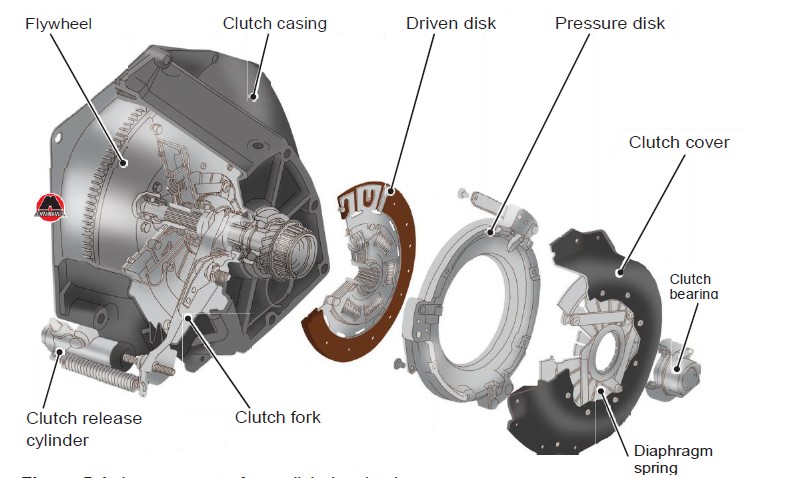5.2.4 Clutch operation
The simplified diagram (Figure 5.3) shows that one clutch disc is connected through the casing and the flywheel to the crankshaft, and the second one is installed on the input shaft of the gearbox. This figure (5.3) also shows the pressure disk, which has the ability to move, as it is attached to the diaphragm spring. This spring, if viewed from the side, has the form of a truncated cone with slots along the entire circumference (the spring is clearly visible in Figure 5.2). These slots form blades, upon pressing which the entire "truncated cone" will bend in the opposite direction. So it turns out that the release bearing presses on the ends of the blades, the spring bends. And since the clutch pressure plate is connected to its outer circumference, it moves and releases the driven disc. At this moment, both discs rotate separately from each other, the crankshaft rotates independently of the gearbox shaft. This means that traction is not transmitted to the wheels - the clutch is disengaged. We release the clutch pedal smoothly - the release bearing moves away from the diaphragm spring The spring takes its original position, the pressure plate tightly presses the driven disk to the flywheel, thereby connecting the crankshaft with the gearbox shaft - the clutch is engaged.
 Figure 5.3 Simplified layout of clutch design.
Figure 5.3 Simplified layout of clutch design.
Interesting
In case if the clutch discs do their job with dry rubbing surfaces, such a clutch is called dry. Conversely, if the clutch workflow takes place in a fluid bath, then the clutch is called wet. The clutch can be single-disc, double-disc and multi-disc. In this case, the definition depends on the number of driven discs in the clutch. The clutch release drive can be cable or hydraulic (in cars) and hydro-pneumatic (in trucks). Also, the clutch can be with mechanical, semi-automatic (automated) and automatic shutdown drive.
 Figure 5.4 Arrangement of one-disk dry clutch.
Figure 5.4 Arrangement of one-disk dry clutch.
The clutch is engaged smoothly in case of a smooth release of the clutch pedal at the beginning of the movement. That is, the pressure disk gradually presses the driven disc against the flywheel (the driven disc slips a little). The number of revolutions of the crankshaft differs significantly from the number of revolutions of the input shaft of the gearbox, but traction is already being transmitted. The car starts moving, and you continue to release the clutch pedal. The driven disk is pressed more and more tightly against the flywheel, the revolutions of the crankshaft and the gearbox shaft are equalized. When the clutch pedal is fully released, the clutch kind of unites the two shafts, and the thrust from the engine is fully transmitted to the gearbox, and from it to the wheels.
Good to know
In case if you do not fully release the clutch pedal for a long time, the driven disc will begin to burn out, as it were, because its working surface is special non-metallic friction linings that tend to wear out. When the clutch disc burns out, the passenger compartment is filled with a characteristic, rather unpleasant, smell.



















2 MB